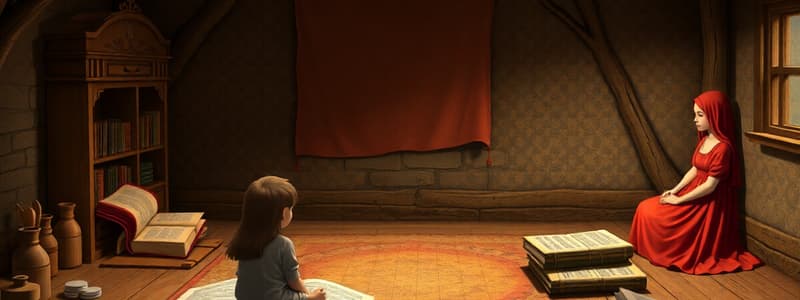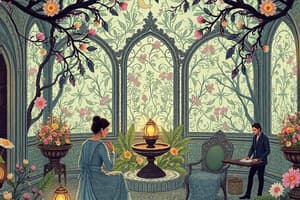Podcast
Questions and Answers
What is the primary function of oxymorons in literature?
What is the primary function of oxymorons in literature?
- To provide comic relief and lighten the tone.
- To intensify emotions and offer nuanced descriptions. (correct)
- To confuse the reader and create ambiguity.
- To simplify complex ideas and make them easily understandable.
The term 'oxymoron' itself is derived from ancient Greek words that represent what contrasting meanings?
The term 'oxymoron' itself is derived from ancient Greek words that represent what contrasting meanings?
- 'Dark' and 'light'
- 'Sharp' and 'dull' (correct)
- 'Love' and 'hate'
- 'Big' and 'small'
How does an oxymoron relate to a paradox in literary terms?
How does an oxymoron relate to a paradox in literary terms?
- An oxymoron is a more complex and extended form of a paradox.
- An oxymoron and a paradox are essentially the same literary device.
- An oxymoron is considered a shorter, simplified version of a paradox. (correct)
- A paradox relies on contradictory terms placed together, unlike an oxymoron.
What effect does sarcasm primarily aim to achieve in literary works?
What effect does sarcasm primarily aim to achieve in literary works?
Which literary figure is recognized for extensively using both oxymorons and sarcasm, influencing later authors?
Which literary figure is recognized for extensively using both oxymorons and sarcasm, influencing later authors?
Which literary element is defined as the author's overarching message conveyed through a story?
Which literary element is defined as the author's overarching message conveyed through a story?
What literary device refers to the perspective from which a story is narrated?
What literary device refers to the perspective from which a story is narrated?
An author's attitude toward the subject matter within a story is best described as:
An author's attitude toward the subject matter within a story is best described as:
The manner in which a writer communicates through specific word choices and sentence structure constitutes their:
The manner in which a writer communicates through specific word choices and sentence structure constitutes their:
Qualities like honesty, courage, and compassion in a character are categorized as which type of character traits?
Qualities like honesty, courage, and compassion in a character are categorized as which type of character traits?
In literature, characters that undergo significant internal change throughout a story are referred to as:
In literature, characters that undergo significant internal change throughout a story are referred to as:
When an author directly states a character's personality traits to the reader, this method is known as:
When an author directly states a character's personality traits to the reader, this method is known as:
Which literary device uses comparison with 'like' or 'as' to clarify understanding?
Which literary device uses comparison with 'like' or 'as' to clarify understanding?
The component of literary analysis that involves going beyond the literal meaning to discern deeper significance is:
The component of literary analysis that involves going beyond the literal meaning to discern deeper significance is:
Which major form of literature is specifically designed to be performed for an audience?
Which major form of literature is specifically designed to be performed for an audience?
What are the core components that define the setting of a story?
What are the core components that define the setting of a story?
Which of the following best describes the nature of the 'place' component within a story's setting?
Which of the following best describes the nature of the 'place' component within a story's setting?
The 'time' element of a story's setting encompasses which of the following possibilities?
The 'time' element of a story's setting encompasses which of the following possibilities?
Which literary techniques are primarily used by authors to effectively establish and describe the setting of a story for the reader?
Which literary techniques are primarily used by authors to effectively establish and describe the setting of a story for the reader?
What type of setting is characterized by a vague and simple time and location, often serving as a minimal backdrop?
What type of setting is characterized by a vague and simple time and location, often serving as a minimal backdrop?
How does the setting of a story primarily influence the plot?
How does the setting of a story primarily influence the plot?
In what way does the setting of a story contribute to the story's mood and theme?
In what way does the setting of a story contribute to the story's mood and theme?
How does the setting of a story play a role in shaping the characters within the narrative?
How does the setting of a story play a role in shaping the characters within the narrative?
Which element of Freytag's pyramid represents the point of highest tension in a narrative?
Which element of Freytag's pyramid represents the point of highest tension in a narrative?
What is the primary function of dialogue in storytelling?
What is the primary function of dialogue in storytelling?
How does a 'theme' differ from a 'moral' in literature?
How does a 'theme' differ from a 'moral' in literature?
Which literary source from Western culture is characterized by stories of gods and heroes designed to explain the world and human nature?
Which literary source from Western culture is characterized by stories of gods and heroes designed to explain the world and human nature?
In the phrase 'The wind whispered secrets through the trees,' which literary device is being used?
In the phrase 'The wind whispered secrets through the trees,' which literary device is being used?
What distinguishes an allegory from other narrative types?
What distinguishes an allegory from other narrative types?
Which of the following is a key characteristic of fables as a type of traditional story?
Which of the following is a key characteristic of fables as a type of traditional story?
How does 'rising action' contribute to the overall plot structure?
How does 'rising action' contribute to the overall plot structure?
Which literary device involves a character directly addressing an inanimate object, an idea, or an absent person?
Which literary device involves a character directly addressing an inanimate object, an idea, or an absent person?
What is the role of 'falling action' in Freytag's pyramid?
What is the role of 'falling action' in Freytag's pyramid?
Flashcards
Setting in a story
Setting in a story
The time, place, and duration of a story. It provides context for events and shapes the characters' actions.
Place in a story's setting
Place in a story's setting
A specific location or environment within the story. It can be real or fictional, and it influences the events and characters.
Time in a story's setting
Time in a story's setting
The point in time when the story takes place. It can be historical, present-day, or futuristic.
Duration in a story's setting
Duration in a story's setting
Signup and view all the flashcards
Physical landscape in a story's setting
Physical landscape in a story's setting
Signup and view all the flashcards
Societal and cultural context in a story's setting
Societal and cultural context in a story's setting
Signup and view all the flashcards
Imagery used to describe a setting
Imagery used to describe a setting
Signup and view all the flashcards
Exposition in a story
Exposition in a story
Signup and view all the flashcards
Oxymoron
Oxymoron
Signup and view all the flashcards
Oxymoron
Oxymoron
Signup and view all the flashcards
Sarcasm
Sarcasm
Signup and view all the flashcards
Paradox
Paradox
Signup and view all the flashcards
Shakespeare's Use of Oxymoron
Shakespeare's Use of Oxymoron
Signup and view all the flashcards
Theme
Theme
Signup and view all the flashcards
Point of View
Point of View
Signup and view all the flashcards
Tone
Tone
Signup and view all the flashcards
Style
Style
Signup and view all the flashcards
Direct Characterization
Direct Characterization
Signup and view all the flashcards
Indirect Characterization
Indirect Characterization
Signup and view all the flashcards
Dynamic Characters
Dynamic Characters
Signup and view all the flashcards
Static Characters
Static Characters
Signup and view all the flashcards
Imagery
Imagery
Signup and view all the flashcards
Simile
Simile
Signup and view all the flashcards
Exposition
Exposition
Signup and view all the flashcards
Rising Action
Rising Action
Signup and view all the flashcards
Climax
Climax
Signup and view all the flashcards
Falling Action
Falling Action
Signup and view all the flashcards
Resolution/Denouement
Resolution/Denouement
Signup and view all the flashcards
Dialogue as a Literary Tool
Dialogue as a Literary Tool
Signup and view all the flashcards
Theme in Literature
Theme in Literature
Signup and view all the flashcards
Myths in Modern Fiction
Myths in Modern Fiction
Signup and view all the flashcards
Allegory
Allegory
Signup and view all the flashcards
Figurative Language
Figurative Language
Signup and view all the flashcards
Study Notes
Setting in Literature
- Setting encompasses time, place, and duration of a story.
- Place can be real or fictional; time can be past, present, or future.
- Authors use details like landscape, climate, and societal context to describe the setting.
- Imagery and exposition are techniques used to establish the setting.
- Imagery uses vivid descriptions appealing to senses.
- Exposition introduces characters, time, and place.
Types of Setting
- Backdrop Setting: Vague and simple time and location.
- Temporal Setting: Focuses on the time period.
- Environmental Setting: Focuses on a specific geographic place.
- Individual Setting: Specific location and time of the story.
The Five Story Elements
- Setting (time and place)
- Characters (people in the story)
- Plot (the story's events)
- Conflict (the problem)
- Resolution (how the problem is solved)
Setting's Significance
- Setting influences plot, mood, theme, and character development.
- Certain actions are more likely to happen in certain settings.
- Characters' backgrounds affect how they interact within the setting.
Characterization
- Characterization is the process of developing characters.
- Direct characterization: Author explicitly states character traits.
- Indirect characterization: Author subtly reveals traits through actions, thoughts, reactions, and speech.
- Dynamic characters: Undergo changes.
- Static characters: Remain unchanged.
Writing Style & Techniques
- Writing style reveals author's identity.
- Diction (word choice) controls reader's perspective.
- Imagery: Vivid descriptions appealing to senses.
- Similes: Comparisons using "like" or "as."
- Symbolism: Using concrete objects to represent abstract ideas.
Literary Analysis
- Literary analysis involves comprehension, interpretation, and analysis.
- Analyze setting, characters, plot, and language.
- Examine the setting accurately.
- Identify themes and morals.
Forms of Literature
- Nonfiction prose: Factual writing (biography, autobiography, etc.).
- Fiction prose: Invented narratives (mystery, fantasy, etc.).
- Poetry: Employs rhythm, meter, and figurative language.
- Drama: Intended for performance (comedy, tragedy).
- Folktales: Stories passed down through generations.
Plot Structure
- Plot follows Freytag's pyramid: Exposition, rising action, climax, falling action, resolution.
- Exposition: Introduces characters and setting.
- Rising action: Events leading to the climax.
- Climax: Point of highest tension.
- Falling action: Events after the climax.
- Resolution/denouement: Conflict resolution.
Dialogue
- Dialogue reveals character traits and advances the plot.
- Dialogue enhances subtext.
Theme
- Theme is the central idea or message.
- Major themes: Appear throughout the work.
- Minor themes: Appear in specific parts of the work.
- Themes are based on personal experiences and views.
- Themes differ from morals (lessons), mood (atmosphere), and subjects (central topic).
Sources for Modern Fiction
- Authors draw from myths, traditional stories, and religious texts (especially the Bible).
- Myths: Ancient stories involving gods and heroes.
- Traditional stories: Fairy tales and fables.
- Bible: Western religious texts with enduring themes.
Literary Devices
- Personification: Giving human qualities to non-human things.
- Apostrophe: Addressing an imaginary person or thing.
- Allegory: Story conveying a larger message using symbolic characters, plot, or setting.
- Fables: Allegories using animals.
- Parables: Allegories using humans.
- Figurative Language: Non-literal language.
- Oxymoron: Two contradictory words together (e.g., bittersweet).
- Sarcasm: Irony to mock or express contempt.
Studying That Suits You
Use AI to generate personalized quizzes and flashcards to suit your learning preferences.




